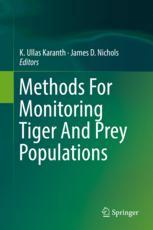

Most ebook files are in PDF format, so you can easily read them using various software such as Foxit Reader or directly on the Google Chrome browser.
Some ebook files are released by publishers in other formats such as .awz, .mobi, .epub, .fb2, etc. You may need to install specific software to read these formats on mobile/PC, such as Calibre.
Please read the tutorial at this link: https://ebookbell.com/faq
We offer FREE conversion to the popular formats you request; however, this may take some time. Therefore, right after payment, please email us, and we will try to provide the service as quickly as possible.
For some exceptional file formats or broken links (if any), please refrain from opening any disputes. Instead, email us first, and we will try to assist within a maximum of 6 hours.
EbookBell Team

5.0
38 reviewsThis book addresses issues of monitoring populations of tigers, ungulate prey species and habitat occupancy, with relevance to similar assessments of large mammal species and general biodiversity. It covers issues of rigorous sampling, modeling, estimation and adaptive management of animal populations using cutting-edge tools, such as camera-traps, genetic identification and Geographic Information Systems (GIS), applied under the modern statistical approach of Bayesian and likelihood-based inference. Of special focus here are animal survey data derived for use under spatial capture-recapture, occupancy, distance sampling, mixture-modeling and connectivity analysees. Because tigers are an icons of global conservation, in last five decades,enormous amounts of commitment and resources have been invested by tiger range countries and the conservation community for saving wild tigers. However, status of the big cat remains precarious. Rigorous monitoring of surviving wild tiger populations continues to be essential for both understanding and recovering wild tigers. However, many tiger monitoring programs lack the necessary rigor to generate the reliable results. While the deployment of technologies, analyses, computing power and human-resource investments in tiger monitoring have greatly progressed in the last couple of decades, a full comprehension of their correct deployment has not kept pace in practice. In this volume, Dr. Ullas Karanth and Dr. James Nichols, world leaders in tiger biology and quantitative ecology, respectively, address this key challenge. The have collaborated with an extraordinary array of 30 scientists with expertise in a range of necessary disciplines - biology and ecology of tigers, prey and habitats; advanced statistical theory and practice; computation and programming; practical field-sampling methods that employ technologies as varied as camera traps, genetic analyses and geographic information systems. The book is a 'tour de force' of cutting-edge methodologies for assessing not just tigers but also other predators and their prey. The 14 chapters here are lucidly presented in a coherent sequence to provide tiger-specific answers to fundamental questions in animal population assessment: why monitor, what to monitor and how to monitor. While highlighting robust methods, the authors also clearly point out those that are in use, but unreliable. The managerial dimension of tiger conservation described here, the task of matching monitoring objectives with skills and resources to integrate tiger conservation under an adaptive framework, also renders this volume useful to wildlife scientists as well as conservationists.